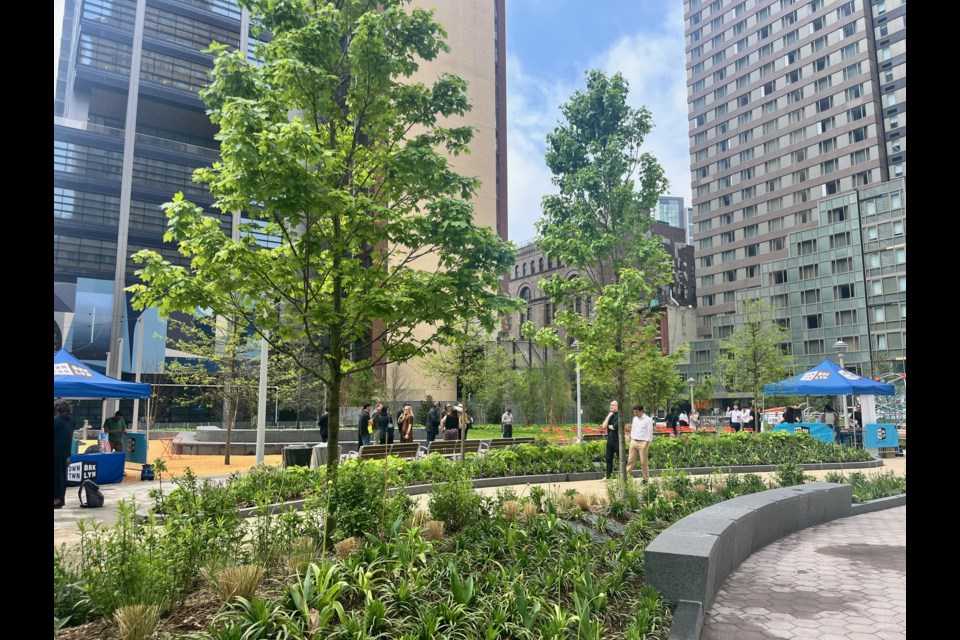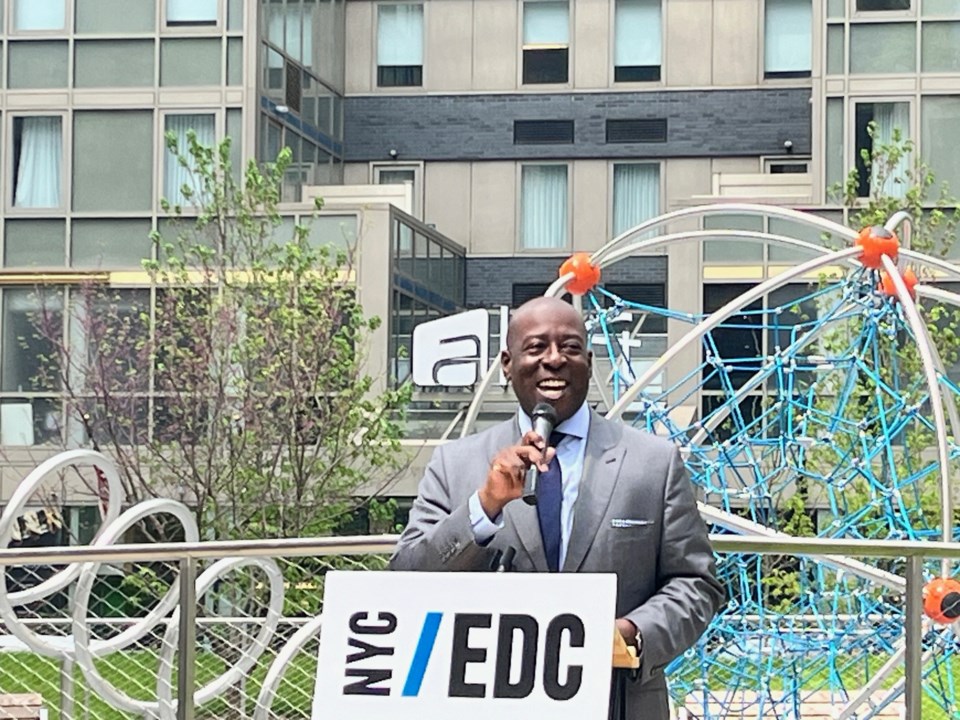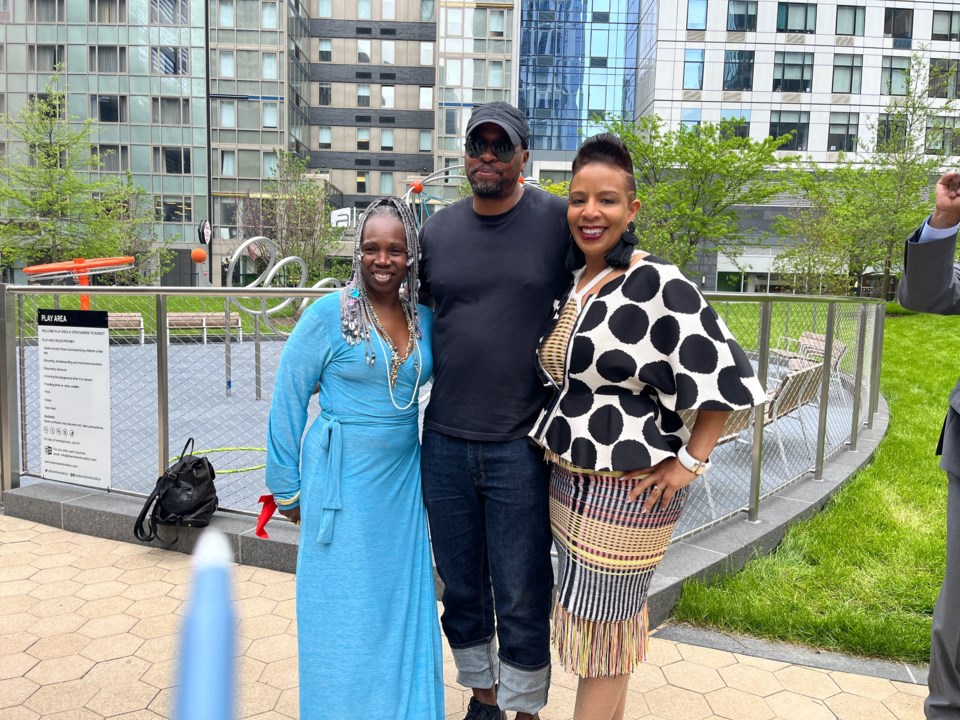After nearly 20 years of planning, meetings and delays, downtown Brooklyn has a new park commemorating the important role abolitionists in Brooklyn played in the freedom of Black people in the United States.
Abolitionist Place officially opened on Wednesday, at 225 Duffield Street.
Designed by the landscape architecture firm Hargreaves Jones, the park, which is a little over one acre, has a small playground and a water play area for children, along with winding paths, benches, a lawn, a dog run and seating areas.
“The open space at Abolitionist Place delivers on a long anticipated and critical improvement to quality of life while following through on a key commitment of the Downtown Brooklyn Redevelopment Plan,” said NYC Economic Development Corporation President Andrew Kimball. “We are excited to see New Yorkers of all ages enjoy the open space and have the opportunity to engage with its historical connections to the Abolitionist Movement.”
That said, park users may be hard pressed to know what those historical connections are– for now.
“The park certainly looks great, but it is not yet finished as there are plans to put up signs that will educate the public about the historical significance,” said Lenny Singletary, chair of Community Board 2. “That is a really important part, as it took us a long time to pressure the city to acknowledge, support and appreciate the history of this area.”
Singletary, who joked that he had an afro when he first started working on the park more than 15 years ago, said city officials had to be educated as to why this area had such a great significance, not just from a historical perspective, but to the area’s long-time Black residents.
“We had to keep asking to preserve what folks did here. It is an accomplishment, and it’s a point of pride,” he said. “It took a lot of education.”
Brooklyn’s active waterfront and large population of free African Americans made the borough a hub of abolitionist activity in the 19th century. There were many abolitionists, both Black and white, that provided temporary shelter to runaways all over Brooklyn Heights and downtown Brooklyn, including inside many of the houses on Duffield Street.
However, when the city rezoned downtown Brooklyn in 2004, it used eminent domain to seize the row homes on Duffield Street, many of which were connected to one another through the basement used as part of the Underground Railroad.
Although some historians had validated the historical significance, it took the city until 2021, or after all the houses were demolished, to approve the one remaining house at 227 Duffield St. as a historical landmark.
This house, currently owned by the city, was once home to Thomas and Harriet Truesdell, who were active in the Abolitionist Movement. After remaining in the Truesdell family from 1851 to 1921, the home was eventually purchased by Joy Chatel in the 1980s.
Known to most as Mama Joy, Chatel tirelessly fought for the house to be landmarked, especially after the Bloomberg Administration announced its renewal plan for downtown Brooklyn.
Many people only knew about the area's history because Mama Joy had signs in front of her home explaining it.
There were many other controversies over the years, including one developer’s desire to make a 700-vehicle parking garage and the original name of the park, Willoughby Square.
“The park does feel like validation of all of my mother’s efforts,” said Mama Joy's daughter, Shawné Lee, at the ribbon-cutting ceremony.
Lee, who is working to turn her mother’s former home into a Abolitionist Heritage Center, said it made her sad that people tried to forget Black history.
“It really did take years for people not to feel intimidated by the rich history of this place,” she said.
Laurie Cumbo, Commissioner of NYC Cultural Affairs, also remarked that Mama Joy understood that “history could not be built over.”
“People risked their lives to unravel the damage of slavery here and that should be preserved and recognized,” Cumbo said.
Singletary hopes there will eventually be historical walking tours of the area and park.
Besides signage, there will be artwork forthcoming: Artist Kenseth Armstead told BK Reader he is awaiting city approval on his installations titled “True North, Every Negro Is a Star,” a huge, perforated steel dome canopy that resembles a celestial map and “Conductors,” which will depict abolitionists James Newton Gloucester, Willis A. Hodges, Mary Joseph Lyons and Harriet and Thomas Truesdell in each corner of the park.
Both installations, scheduled to be finished in 2026, are meant to engage an experience for the viewer, Armstead said.
“I use poetic physicality that evokes the subject matter,” he said.
The park will be maintained by the Downtown Brooklyn Partnership, which will also provide various programming.
“This is a pinch-worthy moment,” said Regina Myer, president of the partnership.





.png;w=120;h=80;mode=crop)
